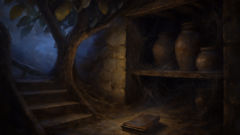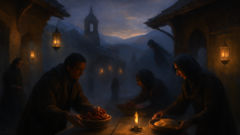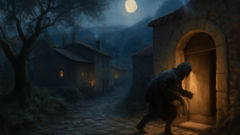Introduction
They say that some things live best in the dark not because they love the dark, but because the dark keeps them honest. In the stone-worn villages that hug the slopes of Greek mountains and in the olive-sour air of winter harbors, older neighbors still speak of a creature that prefers tunnels and root-soft soil to hearth-fire and human company. They call him the Karkantzaros — a goblin whose name rattles like old keys and whose habits are tied to the twelve days between Christmas and Epiphany. By day he sleeps beneath cellar stones and under fig trees; by night he dreams up grievances and keeps a ledger of small debts: a cracked dish left unglued, a child's promise broken, a kindness not returned. When the moon is thin and the world is wrapped in the soft sigh of winter, the Karkantzaros wakes. He surfaces without warning, a crooked silhouette passing between chimneys and ivy, taking what is owed and repaying what he decides must be repaid. The story that follows is neither a mere scare to hush naughty children nor a ghostly jest. It is a portrait of a creature whose mischief reveals the living truths of village life — of memory and duty, of rituals that stitch the living to the dead, and of how communities balance punishment with mercy under the long, cold sky. You will meet families who bargain with him, priests who offer prayers to quiet him, and children who leave small offerings of bread and coins to tip the scales of his temper. You will walk cobbled lanes that smell of pine and roasting chestnuts, slip across frozen village wells, and listen as a grandmother’s voice folds history into cautionary song. This tale preserves the hush and humor of oral tradition: it demands attention to small things — to the clink of a spoon, the slump of an unpaid swear, the warmth of a returned loaf — because in the Karkantzaros's calculations, such things add up to fate and mercy alike.
The Ledger Under the Figs
In the first chapter of every telling, the Karkantzaros is given a reason. Some elders insist he was once a shepherd whose debts and slights accumulated until he could bear no longer; others claim he is a spirit older than the first olive tree, a remnant of winter rites that predate the church bells and the painted icons. The stories vary, but the central image remains the same: a small ledger, a fist-sized book of names and wrongs that he carries tucked beneath his leather jerkin. The ledger is not an instrument of vain cruelty. It records—line by patient line—the contracts of ordinary life: a promise to fetch water that went unfulfilled, a vow to mend a neighbor’s roof left loose, a child's fruitless apology. On nights when the village is tight with frost and the sea beyond the headland hums low and metallic, the Karkantzaros walks the lanes and consults that book.

The first time my grandfather told me about the ledger, he did so while we shelled broad beans by the hearth. The light from the coal pit wavered across his face, and he tapped the table as if summoning the sound of pen against paper. He said the Karkantzaros prefers narrow doors: cellars where wine barrels drip and rooms where the mortar is soft enough to pry. He moves like a thief but judges like an old magistrate. He will steal petty things—buttons, spoons, silver coins—if he finds a ledger entry that names a cruelty. But he balances his taking with a peculiar justice: he can leave a baby's shawl at a doorstep, or return a ring to a widow, or rearrange a household's bread so that those who starved the most find a little more the next morning. People who have lived near the fig tree that shades the village square will tell you that if you listen on certain nights you can hear his mutterings—a language like gravel—half complaint, half accounting. On the ninth night of the twelve days he makes his most rigorous checks, opening the ledger to those lines that have been left unseen all year.
Families learn the rules as if they are laws. A shamed artisan once told my mother that he learned to stitch a crooked seam straight after the Karkantzaros removed all of his finished buttons during Epiphany week. A baker swore that the goblin unbent his scales because the baker had given short measure the previous autumn; the next morning a loaf mysteriously split into equal pieces, each fragrant and generous. These are small miracles and small punishments, and they weave themselves into the village memory. But the ledger also records the more subtle debts: a grandmother’s songs ignored, an unvisited cousin, a promise to plant a sapling that is forgotten. The Karkantzaros measures not only theft but neglect. He is a creature of thresholds—between seasons, between kindness and neglect, between what is remembered and what is allowed to rot. This is the heart of the folktale: in villages where neighbors share wells and gossip, miserliness cannot hide. It will be taken not by thieves in broad daylight, but by a pale figure who counts with the solemn patience of winter and always asks one question before he leaves: Who will remember the forgotten?
This ledger, the elders say, can be read only by those who have been marked. To be marked is neither honor nor shame; it is a summons to repair. The Karkantzaros does not always act alone. Sometimes he coaxes children into mischief to teach a lesson: a pair of shoes left by the door will vanish, only to be found the next dawn mended and polished. Sometimes the creature corners a boastful man in a doorway and replaces his boasting with humility by clinking his spoils where they cannot be seen. There are times when the ledger records such grievous wrongs that whole households must perform atonement—burning incense, sharing the evening bread, weaving garlands of bay leaves for the churchyard. When atonement is made, the Karkantzaros will sometimes leave something unexpected: a carved wooden bird on a windowsill, a sprig of rosemary on a table, a small coin in the palm of a sleeping child. The gifts are never extravagant. They are gestures consistent with the ledger’s aim: to balance, minimally and inexorably, the scales of community life.
As winter deepens, the atmosphere thickens: snow in the uplands turns the black soil into a white map of paths, and the Karkantzaros can be seen in the stories as a fleeting shadow by lamplight. Parents will point him out to children in half-whispered tales: “He will come if you forget to share your bread,” they say, “or if you laugh at an old woman’s prayer.” But the warnings are not meant only to frighten. They are instructions for how to live with one another when the cold makes every act of kindness more costly. The ledger is thus also a mirror: read alongside it are the village lists of births, harvests, weddings, and losses. He who reads the ledger learns what the village has chosen to remember and what it has chosen to neglect. In that way, the Karkantzaros is as much an archivist as he is a mischief-maker. In the end, his appearances remind people to repair their world while repair still costs something.
Twelve Nights of Misrule and Mercy
The ritual calendar of the village bends around the twelve days that mark the Karkantzaros' season. Beginning on the night of Christmas and ending at Epiphany, the twelve nights are a kind of liminal time—threshold nights—when ordinary rules loosen and the creature practices a mischievous jurisprudence. Each night has a tone: the first night is testing, the second night pugnacious, the third night cunning. By the seventh night he is at his most playful; by the ninth night he leans toward severity; by the twelfth he decides whether to return the ledger to its hidden place or carry it deeper into the earth for another year. Households observe simple practices to appease or ward him. They will set a bowl of pomegranate seeds or a slice of onion by the hearth, leave a small towel on the windowsill, or hang a thread of garlic. These offerings function as both bribes and reminders—bribes that are small and symbolic, reminders that the family remembers to be kind.

When I was a child I joined the house preparations with earnest hands. My mother would set a thin plate of sesame cookies and a cup of black coffee behind the oven, in a place where the hearth’s warmth met the crawlspace. “He likes bitter things,” she would whisper, laughing and watching my face. The Karkantzaros, in some tellings, has a taste for stubborn flavors—bitter, sour, sharp—the kind that coax him toward reflection rather than revenge. Other families leave tiny toys in their mantels; others place a storybook by the kitchen bench in case he wants to remember his own childhood. If the household neglected its obligations during the year, the Karkantzaros might rearrange implements in a way that embarrasses the head of the house—sowing a small chaos to point out disorder. Tools might be found in odd places, or keys replaced with pebbles, or boots swapped so that one finds a single slipper on the roof. It is the nature of his pranks to expose sloppiness and to force the household to come together in remedy.
The nights are also times when the village's moral imagination sharpens. Priests will sometimes bless thresholds after the first midnight service, and some households invite a visiting elder to recite old incantations that mix Christian and pre-Christian rites—crosses tied with laurel, verses whispered against envy. Yet there are times when the Karkantzaros will not be placated by prayers, because his ledger cares less for doctrine than for action. He asks for repair, and repair is always practical: a mending of a torn jacket, a letter written to an absent friend, a loaf shared with a widow who has little. In the stories I collected, the most memorable exchanges occurred not when a family paid him off but when they changed. One family, who had been known for their stinginess, discovered their unloved house ornamented the next morning with tiny woven straw hearts and a note scrawled in small, scratchy handwriting: Remember to love. The effect was not merely external; the family began to host the neighbors for soup, and the ledger’s mark lightened the following year.
Not all meetings end with soft resolutions. There are darker tales—stories told in the hush of winter markets—of those whose ledger entries were so long that the Karkantzaros could not forgive. A greedy merchant who cheated a traveling widow was said to have found his stall overturned, with scales balanced only by stones and his ledger entries turned into birds that flew out the window and pecked at his bread until he learned to share. A man who abandoned his oath to anchor a neighbor’s boat was left one morning to find his own net empty, though the sea that day had been bountiful. But these stories also carry hope: they tell of second chances. A woman who once refused to help a beggar returned in shame to mend the man’s tattered coat, and later reported that a small silver coin appeared under her pillow each December until she had finished her penance. The Karkantzaros, in these accounts, enforces a brand of justice that is corrective rather than annihilating.
There are also moments when the Karkantzaros' mischief becomes a test of ingenuity. Village children will plot tiny traps that must not harm him—arrangements of straw and ribbons to see if he takes the bait, whispers of riddles left near his usual haunts. One such prank, told with particular delight by the elders, involved a group of children who replaced the Karkantzaros’ ledger with a child's scribble-book. The creature, arriving to check names, sat and read for so long that he forgot to take the spoons he sought; instead he laughed in the way that older people laugh when the world exhibits unexpected tenderness. That laughter, the elders said, was a rare and generous sound: it meant that the ledger’s burden had been lightened by play. For the Karkantzaros is not a simple villain; he thrives on reflection. If given a moment of human folly turned to joy, his hunger for revenge might be satisfied by the mere memory of laughter.
This tension—between misrule and mercy—deepens as the nights pass. By the tenth night, when Epiphany nears, the village prepares for final reckoning. People will sweep thresholds with spruce and salt, leave bread for neighbors they have offended, and arrange a communal bowl where one can anonymously place a small coin with a note: a confession, a promise, an apology. These anonymous acts are the social mechanism of atonement; they reduce the ledger’s entries by human initiative. On some twelfth nights the Karkantzaros stands at the center of the square, unseen but felt, as village voices sing old songs. The children run round and round, and the elders watch to see whether coals will pop or whether a loose tile will fall—a sign that the creature has decided to move his ledger farther into the earth, content that the village has remembered its duties. When he leaves, the Karkantzaros does so with a clatter of small metal trinkets and a smell of root earth. He is gone until the following year, leaving behind not only stories but shifts in behavior: neighbors who now visit the lonely, fathers who now teach their sons to mend, and bakers who measure with steadier hands. The ledger remains, hidden yet present, as if the village itself remembers to keep account.
Conclusion
By the time Epiphany's lanterns burn low, the story of the Karkantzaros has done its work: a year's small cruelties have been named and, where possible, repaired; new songs have been learned; and the ledger, real or imagined, has returned to its dark place beneath the earth. The folktale does not promise tidy endings—sometimes debts remain; sometimes consequences are severe—but it preserves a hopeful demand: that communities remember to care for each other when the cold presses in and everyday kindness costs something. The Karkantzaros, then, is less a monster than a reminder, an unruly conscience wearing a leather jerkin and carrying a pen. He measures the quiet transactions of human life and turns mischief into moral attention. In villages where the tale is still told, parents do not merely hush children with threats of goblins; they offer ways to make amends, to bake an extra loaf, to sit with the lonely. That is his true power: to turn fear into habit and habit into gentleness. If you ever walk a winter lane and find a scrap of straw or a tiny carved bird left by your door, consider it a nudge rather than a curse. The Karkantzaros has passed by; he has taken nothing you could not spare and perhaps left you something to remember.













